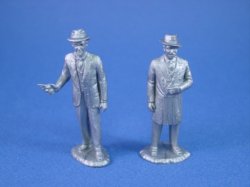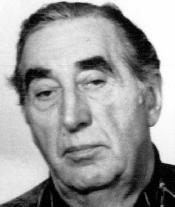
Eliot Ness was born April 19, 1903 in Chicago, Illinois. He was the youngest of five siblings born to Norwegian immigrants, Peter and Emma Ness. Ness attended Christian Fenger High School in Chicago.(now closed because of student violence)
 He was educated at the University of Chicago, where he was a member of the Sigma Alpha Epsilon fraternity, graduating in 1925 with a degree in economics.
He was educated at the University of Chicago, where he was a member of the Sigma Alpha Epsilon fraternity, graduating in 1925 with a degree in economics. He began his career as an investigator for the Retail Credit Company of Atlanta. He was assigned to the Chicago territory, where he conducted background investigations for the purpose of credit information. He returned to the University to take a course in criminology, eventually earning a Master's Degree in the field.
He began his career as an investigator for the Retail Credit Company of Atlanta. He was assigned to the Chicago territory, where he conducted background investigations for the purpose of credit information. He returned to the University to take a course in criminology, eventually earning a Master's Degree in the field.
It was lucky that America also had scandanavian refugees as Eliot Ness one of greatest lawmen came from that ilk. His showdown with Capone showed the difference between where an immigrant comes from unfortunately.
His showdown with Capone showed the difference between where an immigrant comes from unfortunately.
In 1926, Ness's brother-in-law, Alexander Jamie, an agent of the Bureau of Investigation (which later became the Federal Bureau of Investigation in 1935), influenced Ness to enter law enforcement. He joined the U.S. Treasury Department in 1927, working with the 300-strong Bureau of Prohibition, in Chicago .The Capone family immigrated to the United States in 1893 and settled at 95 Navy Street, The Capone family immigrated to the United States in 1893 and settled at 95 Navy Street, in the Navy Yard section of downtown Brooklyn, near the Barber Shop that employed Gabriele at 29 Park Avenue. When Al was 11, the Capone family moved to 38 Garfield Place in Park Slope, Brooklyn.in the Navy Yard section of downtown Brooklyn, near the Barber Shop that employed Gabriele at 29 Park Avenue. When Al was 11, the Capone family moved to 38 Garfield Place in Park Slope, Brooklyn.The Capone family immigrated to the United States in 1893 and settled at 95 Navy Street, in the Navy Yard section of downtown Brooklyn, near the Barber Shop that employed Gabriele at 29 Park Avenue. When Al was 11, the Capone family moved to 38 Garfield Place in Park Slope, Brooklyn.Shortly after he was expelled, his father moved the family to 21 Garfield Place, in the neighborhood that would influence the direction of Capone's life and ultimately, his future. Capone joined two local street gangs, the Brooklyn Rippers and the Forty Thieves Juniors. Among the members were Johnny Torrio and Lucky Luciano
.The Capone family immigrated to the United States in 1893 and settled at 95 Navy Street, The Capone family immigrated to the United States in 1893 and settled at 95 Navy Street, in the Navy Yard section of downtown Brooklyn, near the Barber Shop that employed Gabriele at 29 Park Avenue. When Al was 11, the Capone family moved to 38 Garfield Place in Park Slope, Brooklyn.in the Navy Yard section of downtown Brooklyn, near the Barber Shop that employed Gabriele at 29 Park Avenue. When Al was 11, the Capone family moved to 38 Garfield Place in Park Slope, Brooklyn.The Capone family immigrated to the United States in 1893 and settled at 95 Navy Street, in the Navy Yard section of downtown Brooklyn, near the Barber Shop that employed Gabriele at 29 Park Avenue. When Al was 11, the Capone family moved to 38 Garfield Place in Park Slope, Brooklyn.Shortly after he was expelled, his father moved the family to 21 Garfield Place, in the neighborhood that would influence the direction of Capone's life and ultimately, his future. Capone joined two local street gangs, the Brooklyn Rippers and the Forty Thieves Juniors. Among the members were Johnny Torrio and Lucky Luciano
Following the election of President Herbert Hoover, U.S. Treasury Secretary Andrew Mellon was specifically charged with bringing down gangster Al Capone. The federal government approached the problem from two directions: income tax evasion and the Volstead Act. Ness was
 chosen to head the operations under the Volstead Act, targeting the illegal breweries and supply routes of Capone.
chosen to head the operations under the Volstead Act, targeting the illegal breweries and supply routes of Capone.
With Chicago's corrupted law-enforcement agents endemic, Ness went through the records of all Prohibition agents to create a reliable team, initially of 50, later reduced to 15 and finally to just eleven men called, "The Untouchables". Raids against illegal stills and breweries began immediately; within six months Ness claimed to have seized breweries worth over one million dollars. The main source of information for the raids was an extensive wire-tapping operation. An attempt by Capone to bribe Ness's agents was seized on by Ness for publicity, leading to the media nickname, "The Untouchables." There were a number of assassination attempts on Ness, and one close friend of his was killed.

The efforts of Ness and his team had a serious impact on Capone's operations. However, Ness had very little to do with the IRS convicting Capone with income tax evasion, which lead to Capone's downfall. In a number of federal grand jury cases in 1931, Capone was charged with 22 counts of tax evasion and also 5,000 violations of the Volstead Act. On October 17, 1931, Capone was sentenced to 11 years in prison, and following a failed appeal, he began his sentence in 1932.
Ness was promoted to Chief Investigator of the Prohibition Bureau for Chicago and in 1934 for Ohio. Following the end of Prohibition in 1933, he was assigned as an alcohol tax agent in the "Moonshine Mountains" of southern Ohio, Kentucky, and Tennessee; and, in 1934, he was transferred to Cleveland, Ohio. In December 1935, Cleveland mayor Harold Burton hired him as the city's Safety Director, which put him in charge of both the police and fire departments. He headed a campaign to clean out police corruption and to modernize the fire department.[9]
By 1938, Ness's personal life was completely transformed, while his career began to have some ups and downs. Ness concentrated heavily on his work, which may have been a contributing factor in his divorce from his first wife, Edna. He declared war on the mob, and his primary targets included "Big" Angelo Lonardo,
 "Little" Angelo Scirrca, Moe Dalitz,
"Little" Angelo Scirrca, Moe Dalitz, John Angerola and George Angersola and Charles Pollizi. Ness was also Safety Director at the time of several grisly murders that occurred in the Cleveland area from 1935 to 1938. Unfortunately, what was otherwise a remarkably successful career in Cleveland, withered gradually. Ness's critics at the time pointed to his divorces, his high-profile social drinking and his conduct in a 1942 car accident.
John Angerola and George Angersola and Charles Pollizi. Ness was also Safety Director at the time of several grisly murders that occurred in the Cleveland area from 1935 to 1938. Unfortunately, what was otherwise a remarkably successful career in Cleveland, withered gradually. Ness's critics at the time pointed to his divorces, his high-profile social drinking and his conduct in a 1942 car accident.Ness moved to Washington, D.C. in 1942, and worked for the federal government in directing the battle against prostitution in communities surrounding military bases, where venereal disease was a serious problem. Ness's later life saw him make a number of forays into the corporate world, all of which failed from his lack of business acumen. In 1944, he left to become chairman of the Diebold Corporation, a security safe company based in Ohio. He ran unsuccessfully for mayor of Cleveland in 1947, after which he was expelled from Diebold. In the aftermath, Ness began drinking more heavily and spending his free time in bars telling (often exaggerated) stories of his law enforcement career. He also spent himself into debt. Ness was forced into taking various odd jobs to earn a living, including as an electronics parts wholesaler, a clerk in a bookstore, and selling frozen hamburger patties to restaurants. By 1953, he came to work for an upstart company called Guaranty Paper Corporation, which specialized in watermarking legal and official documents to prevent counterfeiting. Ness was offered a job because of his ex
 pertise in law enforcement. The company soon moved from Cleveland to the quiet rural town of Coudersport, Pennsylvania where operating costs were lower. He made a decent income from GPC and moved with his wife and adopted son into a modest rental house. Once again, he enjoyed going to local bars and regaling amazed audiences with his tales of crime fighting. He collapsed and died at his home of a massive heart attack on May 16, 1957. Collaborating with Oscar Fraley in his last years, he co-wrote the book, The Untouchables, which was published a month after his death.
pertise in law enforcement. The company soon moved from Cleveland to the quiet rural town of Coudersport, Pennsylvania where operating costs were lower. He made a decent income from GPC and moved with his wife and adopted son into a modest rental house. Once again, he enjoyed going to local bars and regaling amazed audiences with his tales of crime fighting. He collapsed and died at his home of a massive heart attack on May 16, 1957. Collaborating with Oscar Fraley in his last years, he co-wrote the book, The Untouchables, which was published a month after his death.Ness was married to Edna Staley (1900-1988) from 1929 to 1938, illustrator Evaline Ness (1911-1986)
 from 1939 to 1945, and artist Elisabeth Andersen Seaver (1906-1977) from 1946 until his death. He also had an adopted son Robert (1946-1976).Ness's ashes were scattered in one of the small ponds on the grounds of Lake View Cemetery, in Cleveland.
from 1939 to 1945, and artist Elisabeth Andersen Seaver (1906-1977) from 1946 until his death. He also had an adopted son Robert (1946-1976).Ness's ashes were scattered in one of the small ponds on the grounds of Lake View Cemetery, in Cleveland.
No comments:
Post a Comment